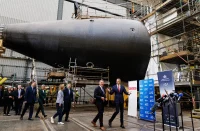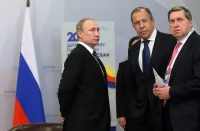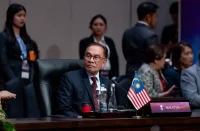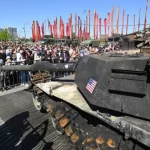On April 30, 1975, footage showing the evacuation of U.S. personnel from the roof of the U.S. Embassy in Saigon by helicopters circled the globe, symbolizing the victorious finale of the Vietnamese people’s struggle for independence and reunification of their country with the most powerful armed forces of the West on the planet. The eleven-year U.S. occupation of South Vietnam ended in a shameful defeat and cost Washington 60,000 death toll plus hundreds of thousands of disabled Americans, huge image losses and disappointment among US allies around the world. Over 5 million Vietnamese also suffered from that war.
48 years have passed since then. Vietnam has grown into a rapidly growing economy from one of the poorest war-ravaged countries in Southeast Asia. Amid deteriorating relations with the PRC after the Sino-Vietnamese armed border conflict in 1979 and weakening of ties with the USSR, Vietnam abandoned the Soviet centralized socialist management system and embarked on a comprehensive political, economic and social reform (“Doi Moi”, renewal policy) that envisaged freedoms for private entrepreneurship, raising foreign credits and loans, reduction of the public sector from 1986 onward. The availability of cheap labor, young and educated population and liberal business laws altogether contributed to attracting significant foreign investment into the Vietnamese economy. From the 1990s on, Hanoi began to gradually build new relations with its former adversary, the United States, on a partnership basis.
Diplomatic relations were established between Vietnam and the United States in 1995. The first visit of U.S. President B. Clinton to Hanoi took place in 2000. The execution of a trade agreement in 2001 contributed to the further expansion of bilateral ties. These efforts culminated in 2013 when Vietnam and the USA elevated their relations to the level of a ‘comprehensive partnership’. From 1995 through 2022, bilateral trade increased from $451 mln to $113 bn with the Vietnamese party achieving a significant surplus. This year, along with Mexico and Thailand, Vietnam has become the key trading partner of the United States.
As a result, more than ten thousand young Vietnamese have received the opportunity to study at American universities. Nguyen Phu Trong, the Secretary General of the Communist Party of Vietnam, paid the first official visit to the United States in the history of Vietnam in 2015. Less than a year later, U.S. President B. Obama paid a return visit to Hanoi which resulted in Washington, among other things, lifting the embargo on the sale of lethal weapons to Vietnam. All the above created new opportunities for improving security relations. Since 2016, the United States has delivered to Vietnam millions of dollars worth of military products, including ships for ensuring maritime security, including coast guard boats, ‘metal shark’ patrol boats and T-6 training aircraft.

The Vietnamese began to take part in the RIMPAC naval exercises of the countries of the Indo-Pacific region on a regular basis. From March 2018 on, when U.S. aircraft carrier Carl Vinson accompanied by missile cruiser Lake Champlain and destroyer Wayne Meyer visited the port of Da Nang for the first time ever, U.S. Navy ships started regularly calling at Vietnamese ports. Last time, nuclear-powered aircraft carrier Ronald Reagan of the 7th Fleet called at Da Nang in June this year.
The improvement of the USA-Vietnam cooperation was fueled by China’s policy in the South China Sea. Beijing claims the disputed Paracel Islands and Spratly Islands located in Vietnam’s exclusive economic zone. China’s taking over these islands may significantly limit Vietnam’s access to natural resources and trade routes and generally reduce strategic autonomy and territories.
It is beneficial for the USA to support this concern of Vietnam given its interest in the PRC being unable to control the South China Sea. US Secretary of Defense Lloyd Austin is quoted as saying: “The Indo-Pacific is at the center of America’s grand strategy” and China may jeopardize its implementation if it succeeds in asserting control over the South China Sea and limiting the USA’s ability to ensure the free movement of goods and deploy its military forces throughout the region.
Washington’s interest in Hanoi also has an economic component. The USA’s stance to curb the development of the Chinese economy and reduce American dependence on trade with China is aimed, among other things, at partially replacing the withdrawing Chinese market with Vietnam in the commodity supply chain. Major companies such as Microsoft, Foxconn, Apple and Samsung (South Korea) have already moved some of their operations to Vietnam to reduce the costs of trade and economic clashes between China and the USA or get rid of Washington’s restrictions on businesses operating in China. This step promotes US-Vietnamese economic cooperation even further.
At the same time, despite the favorable changes in bilateral ties and overlapping interest, no further improvement in relations has been observed so far despite U.S. political experts’ forecasts that they would rise to a level of “strategic partnership” this year. The visit of U.S. Secretary of State E. Blinken in Hanoi in March this year, previously announced as a breakthrough one, yielded no results, except for general protocol statements about the parties’ willingness to continue efforts to improve relations.
The lack of progress is explained primarily by the fact that Hanoi is trying to avoid getting too close to Washington to level out excessive backlash from Beijing and the potential imposition of economic sanctions. Vietnam learned a practical lesson when China imposed higher tariffs on imported Australian agricultural products in 2020 in response to Canberra’s provocative calls for an investigation into China’s involvement in coronavirus strains leaking from a Wuhan biological laboratory.
Considering Vietnam’s geographic proximity to China and its great economic dependence on it, Vietnam’s caution is fairly understandable. Such reality makes Hanoi very vulnerable, especially given its skepticism about the real possibilities and Washington’s willingness to offset the adverse economic consequences of potential Chinese sanctions. In other words, Vietnam values the USA as a security partner to contain China; however, the development of this partnership, in the opinion of the Vietnamese leadership, must not prejudice normal business relations with Beijing. That is why Hanoi rejected the USA’s request to rent a naval Cam Ranh referring to the main principle of its foreign policy, that is maintaining peaceful and friendly relations with more developed and influential states while refusing to participate in any military alliances and hosting foreign bases.
Describing the state of the U.S.-Vietnamese relations, editor of U.S. magazine The Diplomat Sebastian Strangio, in an article published on the eve of the last visit of U.S. Secretary of State E. Blinken to Vietnam, wrote that Hanoi’s greatest expectations from its relations with Washington included: strategic autonomy, economic growth and maintaining the rule of the Communist Party of Vietnam. The USA, in turn, sees Vietnam as a potential ally in containing the increasingly growing “Chinese power and influence in the region.”
In addition, there are other reasons hindering the progressive development of relations with the USA. The Vietnamese government has existential concerns about too close relations with the USA and their consequences for domestic political processes and the preservation of Vietnamese society’s traditions given the high likelihood of Americans imposing their extrinsic Western values. The Vietnamese are also somewhat annoyed by the USA’s procrastination in detoxifying and reclaiming the tropical forests and lands poisoned by the Agent Orange chemical during the Vietnam War.














Comments